
|
The emission of aerosols from the manhole can, for example, be prevented by using the blower device "Aerokill". Driven by the vehicle hydraulics, this device generates a strong air-flow above the manhole opening which forces the aerosol and water mist to collide with the inner wall of the manhole. This reaction causes the aerosols and the water mist to disperse and drain back into the sewer. Due to its high air conveying performance, the system is … |

|
Other preventive measures against the formation of aerosols and against their negative effects include: -
Use of invert nozzles in large sewer cross-sections,
-
Reduction of the pump pressure approximately 10 m before reaching the starting manhole,
-
Use of breathing- and eye protection
-
Covering the manhole opening with a steel or plastic cover equipped with openings for the HP flushing hose and the suction tube.
[ATV1997] |

|
|

|
Based on the practical experience and research findings of Prof. Dr.-Ing. Stein and Partner GmbH and literature research, the following suggestions and recommendations should be considered to ensure a professional use of high-pressure cleaning in order to avoid damages: -
In choosing the operating parameters (nozzle type, flow rate, angle of radiation, and pressure at the nozzle), the pipe material, the wall thickness, and especially the structural …
|

|
-
In the case of damage-free sewers, the pressure at the nozzle should not exceed 120 bar. The corresponding pump pressure is to be determined and regulated considering the individual limiting conditions.
-
When sewers are damaged, a much lower pressure has to be used at the nozzle. The load caused by the high-pressure water jets can be decreased by increasing the distance between the nozzle and the pipe wall, e.g. by using a guidance device (skids …
|

|
-
Under no circumstances should the cleaning nozzle pause in one location while in operation, because the development or increase of damages in sewers, especially at joints and protruding side branches has to be avoided.
-
Before the start of the cleaning measure, it has to be checked whether the nozzle apertures are clogged to avoid additional and uncontrolled reaction forces at the nozzle and increased stress imposed on the pipe walls.
-
If the chosen …
|

|
-
During the suction process, it has to be ensured that the suction tube is lowered into the shaft slowly to avoid damage to the gutter or benching.
-
At temperatures of < 0° C, the cleaning vehicles are to be equipped with frost protection covers to avoid freezing of pumps and lines. The covers also provide a protective function against noise.
-
Plastic hoses are preferred over rubber hoses due to their superior hydraulic characteristics and lower …
|

|
High-pressure cleaning often results in strong air flows. This interaction produces a high and low pressure jump at the nozzle., i.e. there is negative pressure in front of the nozzle (nozzle head) and positive pressure behind the nozzle (jet area). When the cleaning nozzle passes side branches (laterals), seal water can be blown out or sucked out from private drain traps (e.g. of toilets or washbasins) hence causing odour nuisances. The pressure … |

|
The following measures can reduce the occurrence of odours: -
Reduction of the pump pressure at the vehicle (resulting in a lower flushing pressure)
-
Choosing the appropriate cleaning nozzle (large jet angles, low number of nozzle inserts)
-
Reduction of the pullback velocity of the nozzle
-
Cleaning of preferably short sections from manhole to manhole
-
Regular removal of waste material within a section
-
Improvement of the aeration (air inlet and outlet), …
|

|
A form of quality control carried out during the cleaning operation involves assessing the noise created by the deposits during suction and visually inspecting the flushing water. Acoustic assessment: mud, rocks or solidified deposits cause noise as they are vacuumed up and hit the suction tube. This provides insights into the degree of contamination and the progress of the cleaning. |

|
Visual assessment: A visual inspection of the flushing waters content and colour provides a general idea of the deposit situation and the cleaning progress. (Image: Visual inspection of the flushing water) (Image: Sewer manhole inspection) |

|
|

|
(Image: Selection of the nozzle and the jet angle) Nozzle: • Number and diameter of openings
• Type of nozzle inserts
• Jet deflection in the nozzle? (Pressure loss) (Image: Deposits sewer - mixtures of organic and mineral substances) Sewer channel
(Cleaning objectives): • nominal size, length, depth material
• structural condition
• quantity and type of deposits
• flow condition and level of backup. (Image: Combined high pressure flushing and suction … |

|
Congratulations! You have successfully finished this module. Next you will have the opportunity to review the newly acquired knowledge with an interactive questionnaire. You can of course still navigate back to any point in the modules if you wish to review a specific point or subject. Stay curious! |

|
|

|
An essential part of high-pressure cleaning are the cleaning nozzles. This module covers the complex task of choosing the optimal cleaning nozzle for the respective application, as there are a multitude of nozzle types with different features available. After completing this module, you will have a sound knowledge of: - the physical mode of action of pressurized water jets;
- selection of cleaning nozzles depending on the cleaning task and
- assessment and recognition of application risks.
|
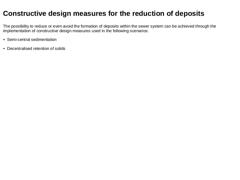
|
The possibility to reduce or even avoid the formation of deposits within the sewer system can be achieved through the implementation of constructive design measures used in the following scenarios: |

|
Semi-central sedimentation includes “measures taken for the retention of solids within sewer networks”. For this purpose, sedimentation systems such as stormwater tanks or sedimentation shafts can be used to collect sediment from precipitation runoff and combined wastewater [SteinR08].
Where conditions permit, these systems can retain heavy solids through the use of settling basins while allowing lighter particles to pass.
|
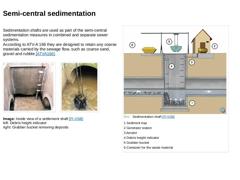
|
Sedimentation shafts are used as part of the semi-central sedimentation measures in combined and separate sewer systems.
According to ATV-A 166 they are designed to retain any coarse materials carried by the sewage flow, such as coarse sand, gravel and rubble [ATVA166]. (Image: Sedimentation shaft) (Image: Sedimentation shaft - Grabber bucket) Image: Inside view of a settlement shaft [FI-VSB]
left: Debris height indicator
right: Grabber bucket removing … |
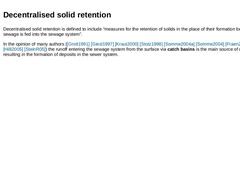
|
Decentralised solid retention is defined to include “measures for the retention of solids in the place of their formation before the sewage is fed into the sewage system”. In the opinion of many authors ( [Grott1991] [Giesl1997] [Kraut2000] [Stotz1998] [Somme2004a] [Somme2004] [Fraen2005] [Hilli2005] [SteinR05]) the runoff entering the sewage system from the surface via catch basins is the main source of mineral solids resulting in the formation of … |
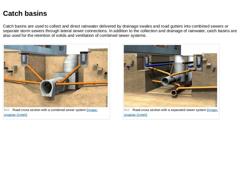
|
Catch basins are used to collect and direct rainwater delivered by drainage swales and road gutters into combined sewers or separate storm sewers through lateral sewer connections. In addition to the collection and drainage of rainwater, catch basins are also used for the retention of solids and ventilation of combined sewer systems. (Image: Road cross section with a combined sewer system) (Image: Road cross section with a separated sewer system) |

|
Catch basins with no sump and a direct invert discharge into the sewer line should use a perforated waste bucket as a sieve retaining coarse debris and floatables, before they enter the sewer system. Any particles that can pass through the waste bucket openings are able to reach the main sewer line via the lateral catch basin line [DIN4052:2006]. (Image: Catchbasin detail - direct discharge) (Image: Catch basin - direct discharge) |
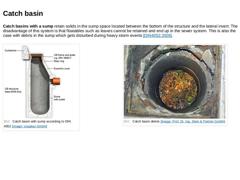
|
Catch basins with a sump retain solids in the sump space located between the bottom of the structure and the lateral invert. The disadvantage of this system is that floatables such as leaves cannot be retained and end up in the sewer system. This is also the case with debris in the sump which gets disturbed during heavy storm events [DIN4052:2006]. (Image: Catch basin with sump) (Image: Catch basin debris) |

|
|
The solid retention in the bucket is essentially influenced by the entry of organic matter in the form of leaves, tree branches and other bulky objects. When a catch basin (CB) does not hold organic matter in its bucket, there is practically no solid retention, because the mineral solids with particle sizes of < 16 mm pass through the slit openings with the slightest volumetric flow. |
Consequently, catch basins with an outlet at the invert level … |
|
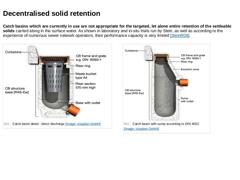
|
Catch basins which are currently in use are not appropriate for the targeted, let alone entire retention of the settleable solids carried along in the surface water. As shown in laboratory and in-situ trials run by Stein, as well as according to the experience of numerous sewer network operators, their performance capacity is very limited [SteinR08]. (Image: Catchbasin detail - direct discharge) (Image: Catch basin with sump) |